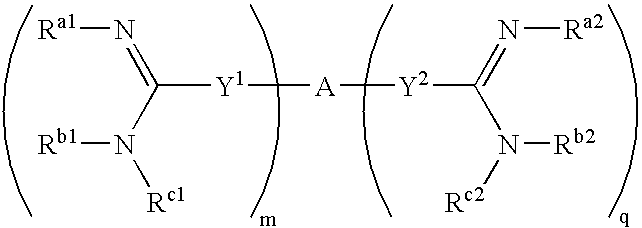Amidine derivatives for treating amyloidosis
a technology of amyloidosis and amyloid derivatives, which is applied in the field of pathological conditions, can solve the problems of no widely accepted therapy or treatment which significantly dissolves amyloid deposits in situ or prevents further amyloid deposition, no widely known or accepted therapy or treatment, and amyloidotic fibrils, once deposited, can become toxic to the surrounding cells
- Summary
- Abstract
- Description
- Claims
- Application Information
AI Technical Summary
Benefits of technology
Problems solved by technology
Method used
Image
Examples
examples
[0222] The synthesis of amidine compounds of the invention is described in U.S. Pat. Nos. 5,428,051, 4,963,589, 5,202,320, 5,935,982, 5,521,189, 5,686,456, 5,627,184, 5,622,955, 5,606,058, 5,668,167, 5,667,975, 6,025,398, 6,214,883, 5,817,687, 5,792,782, 5,939,440, 6,017,941, 5,972,969, 6,046,226, 6,294,565 (B1), 6,156,779, 6,326,395, 6,008,247, 6,127,554, 6,172,104, 4,940,723, 5,206,236, 5,843,980, 4,933,347, 5,668,166, 5,817,686, 5,723,495, 4,619,942, 5,792,782, 5,639,755, 5,643,935, 5,602,172, 5,594,138, and 5,578,631. Additional synthesis protocols may be found in PCT Patent Application Publication No. WO 2003 / 017,994. Many of the compounds may also be purchased from Sigma-Aldrich Co. (Milwaukee, USA). The compounds may also be synthesized according to art-recognized techniques.
[0223] In general, the compounds of the present invention may be prepared by the methods illustrated in the general reaction schemes as, for example, described below, or by modifications thereof, using r...
PUM
| Property | Measurement | Unit |
|---|---|---|
| concentration | aaaaa | aaaaa |
| particle size | aaaaa | aaaaa |
| size | aaaaa | aaaaa |
Abstract
Description
Claims
Application Information
 Login to View More
Login to View More - R&D
- Intellectual Property
- Life Sciences
- Materials
- Tech Scout
- Unparalleled Data Quality
- Higher Quality Content
- 60% Fewer Hallucinations
Browse by: Latest US Patents, China's latest patents, Technical Efficacy Thesaurus, Application Domain, Technology Topic, Popular Technical Reports.
© 2025 PatSnap. All rights reserved.Legal|Privacy policy|Modern Slavery Act Transparency Statement|Sitemap|About US| Contact US: help@patsnap.com



